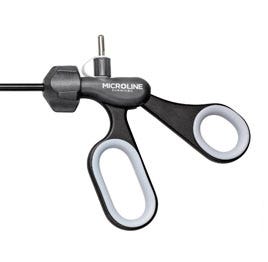Getting the Most Out of Product Development and Contract Manufacturing
December 7, 2013
A medical device company can be well-served when medical device engineers start out the gate with agreed-upon product requirements that have a minimal chance of changing down the road, says Chris Devlin, senior director, research and development at Microline Surgical. Product requirements are not a trifling matter; they can make or break a product or even a company, Devlin explained last week during BIOMEDevice San Jose.
To that end, R&D engineers should collaborate with the company's marketing and operations team to develop a concrete strategy for short- and long-term manufacturing.
|
When developing this IV handpiece, Microline Surgical Inc. specified high dielectric strength PEEK for the shaft material. |
From a technological perspective, Devlin stressed the importance of thoroughly understanding how adequately the need can be addressed with technology currently on the market. This includes considering the pros and cons of various technologies of the market and an analysis of how those products address human factors. This process helps inform the formulation of product specs. A scientific advisory board can prove invaluable when doing this research.
While having stable product requirements is invaluable, it is also a good idea to engineer the product so that it can readily accommodate various materials and components to conform to evolving energy specifications and regulatory requirements. Engineers can take a proactive role in researching new proposed regulations and adapt product design accordingly. "By designing with the anticipated changes in mind, your company can keep producing while your competitors struggle to get their products compliant," Devlin said.
Devlin also recommended sourcing back-up materials and technologies for critical components and advocated for thorough biocompatibility testing for the materials used in the device, if it will come in contact with or will be used within patients.
Contract manufacturers and suppliers can assist with this work and can provide invaluable feedback in product design. Still, the relationship between medical device manufacturers and contract firms is rarely ideal. To help improve the relationship, it is a good idea to do thorough due diligence when selecting suppliers and to make sure the firm has considerable experience fabricating the types of components you need. Once you have found a firm that can work with yours as a true partner, both entities can help share the risk of product development and achieve more consistent results through collaboration.
Domestic contract manufacturers can often compete with offshore firms in terms of cost. And frequently, domestic outsourcers can develop the parts your firms need much quicker than their offshore peers. While an offshore firm may quote you with a less expensive price for parts, the possibility of having to rework those parts can translate in significantly higher cost in the long run.
Brian Buntz is the editor-in-chief of MPMN. Follow him on Twitter at @brian_buntz and Google+.
About the Author(s)
You May Also Like


.png?width=300&auto=webp&quality=80&disable=upscale)
